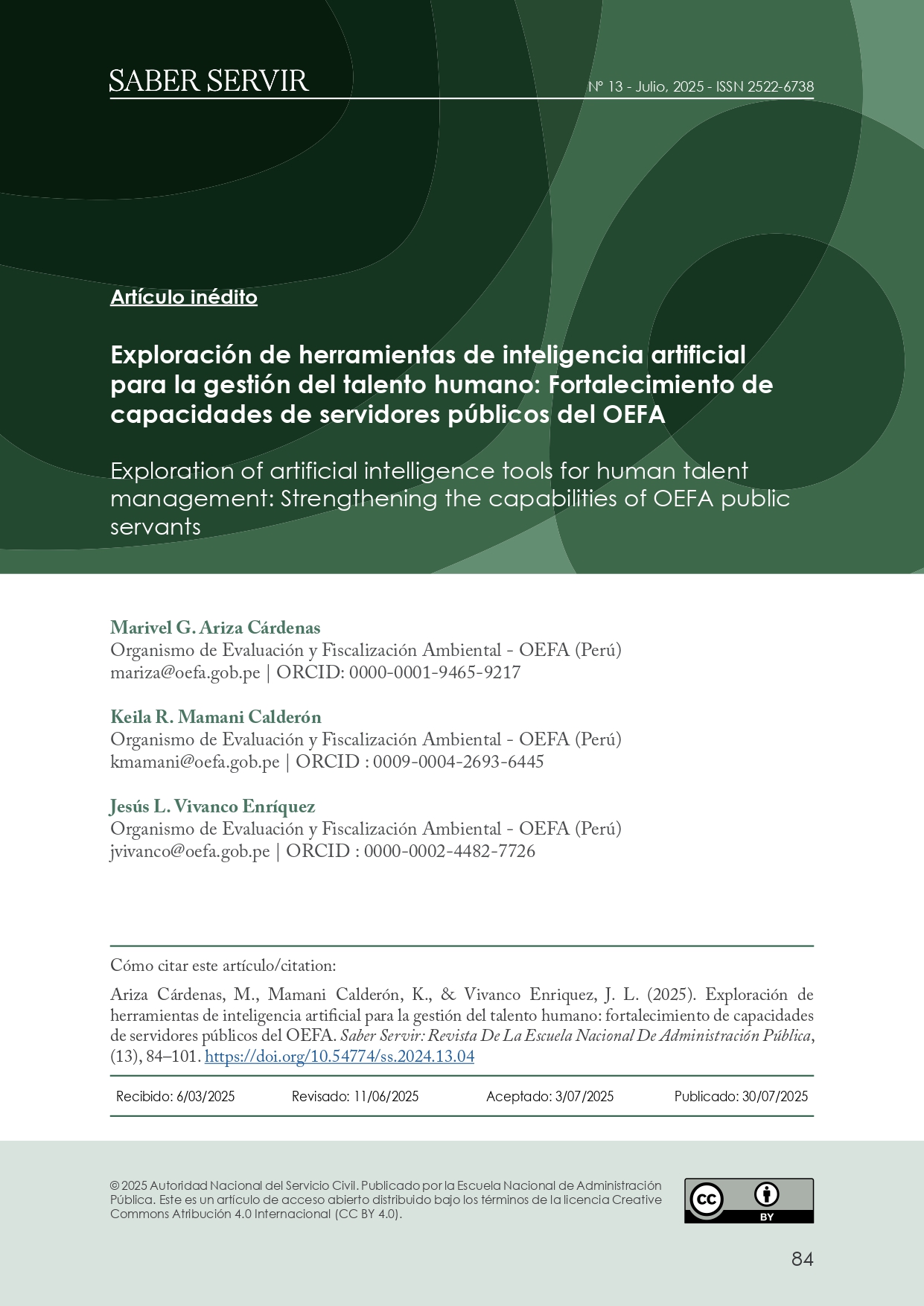

Los contenidos publicados en la revista están bajo una licencia CC-BY 4.0, la cual permite:
- Compartir, copiar y redistribuir el material en cualquier medio o formato.
- Adaptar, remezclar, transformar y construir a partir del material para cualquier propósito, incluso comercialmente.
Bajo los siguientes términos:
- Atribución. Usted debe dar crédito de manera adecuada, brindar un enlace a la licencia, e indicar si se han realizado cambios. Puede hacerlo en cualquier forma razonable, pero no de forma tal que sugiera que usted o su uso tienen el apoyo de la licenciante.
Todos los autores deben descargar, completar, firmar y remitir a través del correo electrónico de la revista revistaenap@servir.gob.pe, la siguiente DECLARACIÓN JURADA DE AUTORÍA Y CESIÓN DE DERECHOS DE AUTOR como requisito indispensable para la publicación del artículo.
Abstract
This article presents an exploratory study on the use of artificial intelligence (AI) tools in public administration for capacity building in the context of the OEFA (Environmental Assessment and Auditing Organism). Practical workshops were held with public servants from the institution. The workshops, developed by the OEFA Library, included practical exercises with AI platforms such as Gemini, ChatGPT, and DeepSeek. After group discussions on the use of AI, a structured questionnaire was administered to assess participants' perception of usefulness (PU) regarding the applicability of AI in the workplace.
The methodology adopted combined qualitative and quantitative approaches, using the Technology Acceptance Model (TAM) to analyze the significant factors influencing public servants' intention to use AI. The results suggest that PU is the main factor motivating AI adoption. In contrast, perceived ease of use (PEOU) did not show a significant impact on intention to use. Although participants highlighted improved efficiency in certain activities and decision-making as key benefits of using these technologies, the findings do not allow for definitive conclusions about the actual effectiveness of AI in improving public management. The study focused primarily on participants' perceptions and expectations. However, key areas were identified where AI could optimize human talent management, particularly in capacity building and skills development for public servants. Finally, it is recognized that, while challenges exist for large-scale implementation, AI tools have significant potential to transform public management and strengthen human talent, contributing to increasingly efficient and strategic administration.
Keywords
References
Criado, J. I. & De Zárate-Alcarazo, L. O. (2022). Technological frames, CIOs, and Artificial Intelligence in Public Administration: A socio-cognitive exploratory study in Spanish local governments. Government Information Quarterly, 39(3), 1-13. https://doi.org/10.1016/j.giq.2022.101688
Davis, F. D. (1989). Perceived usefulness, perceived ease of use, and user acceptance of information technology. MIS Quarterly, 13(3), 319-340. https://doi.org/10.2307/249008
Garca, I. S. (2021). Artificial intelligence risks and challenges in the Spanish public administration: an exploratory analysis through expert judgements. Multidisciplinary Digital Publishing Institute. https://doi.org/10.3390/admsci11030102
Glaze, K., Ho, D. E., Ray, G., y Tsang, C. (2021). Artificial intelligence for adjudication: the social security administration and ai governance. Social Science Research Network. https://doi.org/10.2139/ssrn.3935950
Kaplan, A. y Haenlein, M. (2019). Siri, Siri, in my hand: Who's the fairest in the land? On the interpretations, illustrations, and implications of artificial intelligence. Business Horizons, 62(1), 15-25. https://doi.org/10.1016/j.bushor.2018.08.004.
Li, Y., Fan, Y., y Nie, L. (2023). Making governance agile: exploring the role of artificial intelligence in China’s local governance. Public Policy and Administration, 40(2), 76-301. https://doi.org/10.1177/09520767231188229
Ojo, A., Mellouli, S., y Zeleti, F. A. (2019). A Realist Perspective on AI-era Public Management. ACM Digital Library, 159 - 170. https://doi.org/10.1145/3325112.3325261
Plantinga, P. (2022). Digital discretion and public administration in Africa: implications for the use of artificial intelligence. Information Development, 40(2), 332-352. https://doi.org/10.1177/02666669221117526
Russell, S., y Norvig, P. (2021). Artificial Intelligence: A Modern Approach. Prentice Hall. https://aima.cs.berkeley.edu/
Sánchez, M. (2022). La inteligencia artificial en el sector público y su límite respecto de los derechos fundamentales. Estudios Constitucionales, 20(2), 257-284. https://doi.org/10.4067/S0718-52002022000200257
Senge, P. (2006). The Fifth Discipline: The Art and Practice of the Learning Organization. Doubleday.
United Nations Development Programme. (4 de noviembre de 2015). Capacity development: A UNDP primer. https://www.undp.org/publications/capacity-development-undp-primer
Vogl, T. M., Seidelin, C., Ganesh, B., y Bright, J. (2020). Smart technology and the emergence of algorithmic bureaucracy: artificial intelligence in UK local authorities. Public Administration Review, 80(6), 946-961. https://doi.org/10.1111/puar.13286
Young, M. M., Bullock, J. B., y Lecy, J. (2019). Artificial discretion as a tool of governance: a framework for understanding the impact of artificial intelligence on public administration. Perspectives on Public Management and Governance, 2(4), 301–313. https://doi.org/10.1093/ppmgov/gvz014










